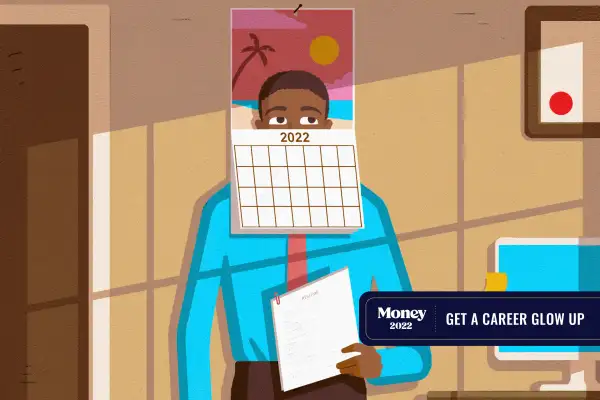How to Make Your Resume Stand Out in 2022

This article is part of Money's January 2022 digital cover, which features 22 ways to make 2022 the best money year of your life. Browse all 22 articles here.
The job search landscape today is almost unrecognizable from what we’ve seen before.
So many people work from home these days that many companies now consider remote work a standard operating procedure. Others are struggling to bounce back from layoffs caused by the COVID-19 pandemic, or belong to the growing number of workers who have quit their jobs in recent months — a group sizable enough to make the term “the Great Resignation” stick.
No matter which boat you’re in, it’s probably high time to give your resume a refresh. But be forewarned: Now, more than ever, hiring managers aren’t going to suffer fools.
“Everyone is fatigued, and attention spans are low,” says Dana Leavy-Detrick, founder of Brooklyn Resume Studio. “It’s that much more important to be concise and impactful.”
Money teamed up with Leavy-Detrick to create an effective resume for the year ahead. Whether you’re starting over completely or want to see what kind of new opportunities are available in your field, here’s how to write a resume worthy of your dream job — and a free resume template to boot.
(Resume design courtesy of Dana Leavy-Detrick; click here for a free downloadable template)
1. Pick a classic resume format and font
When it comes to resume format and design, opt for a clean layout. A 2018 study from the job site Ladders found that resumes with so-called F-pattern and E-pattern layouts, which mimic how our eyes scan web pages, hold a recruiter’s attention for longer than those aligned down the center, or from right to left.
A word on font: There’s no specific "best" font for resumes, but you should use the same font style throughout, Leavy-Detrick says. Play with different weights and sizes to draw a recruiter’s eye to key parts of your resume (check out the bolded figures on our resume template for ideas). Sans serif fonts like Arial or Calibri are usually good bets.
2. Don’t be afraid to go bold
If you’re applying for an investment banking job, a hot-pink resume probably won’t do you any favors. But subtle pops of color, like the orange used here, will work for just about everyone.
Another strategy for making your resume stand out is, of course, with the content you put on it. In 2022, you’ll get extra credit for highlighting your resilience. How have you dealt with change and managed your time over the strangest two-year period most of us have experienced? Kept your team engaged and mitigated turnover? Shaped company culture in a hybrid work environment — where coworkers are now living in different cities, and maybe even different time zones?
“The work environment has changed,” Leavy-Detrick says. “Employers have had to adjust.” Prove that you can too.
3. Add a skills section with bullet points
Skip the resume objective (nobody cares what you’re "searching for") and lead with the good stuff instead. The top of your resume should include "critical keywords and a quick snapshot of your core strengths,” Leavy-Detrick says. Bullet points are a solid choice — they stand out even if someone is just skimming your resume.
Hard skills (tangible attributes that can easily be measured) also take precedence here, so highlight them accordingly. If you’re in a tech-driven field, software and programming expertise is what employers want to see on your resume. If you’re in a creative industry, design and communication skills might be your best bet.
This is another opportunity to show how you’ve helped your company “disperse change,” since the onset of the pandemic, Leavy-Detrick says. Tech skills that prove you’ve got some new digital know-how, even if it’s just with Zoom and Slack, are fair game.
4. Show how you make an impact
List your relevant work experience in reverse chronological order, and use action verbs (“generated,” “spearheaded,” “executed”) where appropriate.
Don’t just list your old job titles. To prove you’re worth a hiring manager’s time, you’ll need to highlight some concrete “wins.” Statistics that build upon your skills section are most impactful — bonus points if they show a track record of growth, revenue, and profitability, Leavy-Detrick says.
If you’re drawing a blank, she suggests adding resume skills that can help solve a “problem area” for the company you’re applying to.
“Impact doesn’t always have to be measured by metrics,” she says. “Cultural improvements, special projects, customer growth … anything that shows success can work.”
Keep things short and sweet — don’t try to list as many projects and responsibilities as you possibly can, Leavy-Detrick advises.
“Focus on a couple of key takeaways,” she says. “Really try to make it a ‘best of’ document.”
5. Add and tweak critical keywords
Don’t make the mistake of answering each job application with the same generic resume. Instead, take a few extra minutes to mirror it to the keywords and phrases within the ad. You’ll be much more likely to make it to the next round of hiring, especially if an applicant tracking system (a computer program designed to weed out candidates out) has anything to do with it.
Avoid cramming in as many keywords as you can, or repeating the same words over and over — you’ll end up sounding like a bot yourself. But do “get as close as you can to the language of the job description,” Leavy-Detrick says. On our example resume, we’ve peppered in keywords from job postings—“marketing deliverables,” “compliance,” “corporate communications”—in a way that sounds natural. (“Make sure you’re speaking to those robots, but also humans,” Leavy-Detrick says.)
Here’s another tip: If you plan to cast a wide net by uploading a general resume to your LinkedIn or Indeed profile, make sure it’s tailored to the primary job you want — then update your keywords when applying to positions that deviate from the norm.
6. Know what to leave off your resume
Millions of workers lost their jobs as a result of the pandemic, and many are still trying to find gainful employment today.
The silver lining, Leavy-Detrick says, is that employers have had to relax some outdated hiring practices as a result. Most noteworthy? Job seekers with a large employment gap on their resume—once seen as a major red flag—are getting a pass.
If your job was a casualty of COVID layoffs, it’s worth showing how you’ve stayed active and kept your skills fresh in the interim — by getting a professional certification, attending virtual webinars, or otherwise.
Be discerning with the rest of the content: Don’t add salary requirements, infographics or photographs. You can also leave off your home address, especially if you’re applying for a remote role, or are hoping to convince a hiring manager to consider a remote candidate.
Lastly, avoid the temptation to tick off every job you’ve ever had.
“The resume is a high-level snapshot of your skills, experience, and accomplishments,” Leavy-Detrick says. If a hiring manager has to scan through a really bulky one, “they’re more likely to miss key responsibilities.”
Anything beyond that is best left for the cover letter.
More from Money:
Use This Script to Ask for a Raise in 2022
Here’s a New Hack for Finding out How Much a Job Actually Pays
